What Is Considered The Most Comfortable Mattress? An Expert Explains What It Takes To Create A Goldilocks Mattress
This is a commonly asked question our readers ask, either by email or on our Facebook page. It’s a valid question to ask, what with the hundreds of mattress options available to purchase online in the “bed in a box” category.
You’ll be bowled over by a tidal wave of options, with everything from all foam mattresses, hybrid beds that feature foam and coil, natural latex, memory foam, and even specialized foams infused with charcoal, lavender, and other materials.
When you start shopping online, it can quickly get confusing and the question that distills down the number of choices quickly comes around to what is the “cake recipe” for a good mattress? What combination of materials or ingredient by itself do mattress buyers believe to be the most comfortable?
Let’s Define Comfortable First
Before qet into the various options that can contribute to the comfort of a mattress, let’s figure out exactly what we are talking about when we describe “comfortable” as far as a mattress goes.
I think it’s fair to say that a comfortable mattress is one that is going to both feel great when you get in bed, in one form or another. That initial impression, that first nestle and settling into your mattress should feel wonderful.
Your body should immerse in the top few layers, and you may feel a melting in sensation or a firmer, more springy feeing depend upon what you choose, but the sensation of “comfort” usually should be tied with support as well.
Comfort and support are two sensations and attributes that need to go hand in hand when you are talking about a mattress, versus, say, a chair. Remember how much time you spend in bed, and how therapeutic it can be for you. It is your refuge, your nest, and your sanctuary.
In addition to being fabulously comfortable and inviting, it also needs to cradle and encase your body properly, providing support that allows you sleep deeply in REM sleep, so your body can restore and heal.
As a mattress engineer, designer, and fabricator, I’ve become pretty familiar with what specific materials actually make up “the most comfortable mattress” based upon decades of customer feedback, reviews, and making little adjustments here and there on already proven recipes.
You can only evaluate the experience of comfort and support if you spend a good deal of time on a mattress, say a full eight hours. If you wake up pain free, it’s likely that the mattress is a good fit for you comfort wise, and that you were properly supported so that you awakened limber, relaxed, and refreshed.
Components That Are Typically Used When Designing A Comfortable Mattress
If you are shopping for a bed in a box mattress, you’re probably spending time on my site to try to narrow down your options. There are over 250 online mattress retailers now, but did you know that only about 15 or so are responsible for about 75% of mattress purchases. And, interestingly, the most popular brands use very similar materials. There actually is a “cake recipe” for the most comfortable mattress.
Let’s start from the bottom up, and you can look for these components once you get shopping, hopefully using our list of curated Trusted Dealers to guide you. If you consider what’s on the bottom of any mattress, it typically begins with a thick and fairly firm support layer, often around 6-7” thick. If you are buying an all foam mattress, the density and firmness level of the bottom section or layer is going to be fairly firm, and the foam material is likely going to be polyurethane.
If you are buying a 100% latex mattress, it will be a fairly firm later of latex foam. The only exclusion from this thicker layer of underlying support foam would be in a hybrid mattress where you have a layer of pocketed coils, usually attached with fabric, connector of some kind, or with the steel coils actually woven together in a rack type of configuration. Typically, though, underneath the coil system on a hybrid mattress you’ll find a very stiff layer of foam that the coils rest upon, often acting as a motion dampening layer.
Let’s discuss the different kinds of foam layers that generally impart a sensation of comfort in today’s most popular selling mattresses.
Support Foam: The Foundation Of A Comfortable Mattress
Even though you won’t be in direct contact with it, that underlying thicker layer of supportive high density polyurethane foam should be quite firm, but with a little bit of give. The purpose of this layer is to allow your body weight to evenly distribute across the surface of the mattress.
It also provide a resilient surface that adds height to the mattress, and provides the spring back up top that will give the top layers elasticity and flex. Typically this layer is high density polyurethane foam that is about 4-5 times as hard as the upper layers, but still with a small amount of yielding sensation.
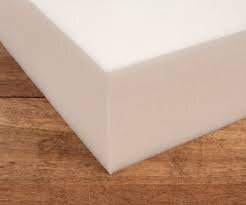
Generally, where online merchants offer different levels of firmness, they may vary the density of this layer slightly, but not as much as the upper “comfort” layers which are found above. The trick with any design is to provide a cake recipe that allows each successive layer to gently immerse into the layer below, without too much sinking or a collapsing feel.
The density of the topmost layer usually varies about 10-15% from the density of the firmer foundation layer.
Memory Foam: Pain And Pressure Relief : It’s What Provides That Sumptuous Feeling On A Really Comfortable Mattress
Memory foam has been around for about 20 years now in the mattress industry, and is likely the most popular component of award winning and super comfortable mattress. Memory foam mattresses are known for their embracing and nest-like support, pressure relief, and body contouring. The material tends to melt around you as it responds to body temperature, and has helped million of people with pressure point issues and pain.
Historically, memory foam has had a bad reputation as “sleeping hot”. However, advances in cooling technology have produced gel/memory foam mattresses that have small beads of stretchable cooling material built into the memory foam. In my opinion, if I were designing the world’s most comfortable mattress, a layer of memory foam would be near the top.
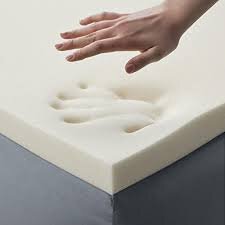
Be careful about what you are buying though. Ask to make sure (by online chat or an in store consultant) about the density of the memory foam that is used, as this is critical for comfort. Buy 4lb. density rather than more economical 3 lb. density. It’s a tad firmer, but you will experience the same kind of melting sensation without bottoming into it, allowing for easier turning and without any trapped sensation.
Natural Latex: Super Responsive, Springy, Sleeps Cool
Most of the time, natural latex is going to be found in a top to bottom all-natural latex mattress. I designed and sold the best latex mattress that is all natural for 15 years on the web, and was one of the first e-tailers to build it into a bed in a box program.
Natural latex is buoyant, has a springier feel with some decent bounce, and owners love how it keeps you “on top of the mattress rather than inside of it”. It is instantly responsive, incredibly comfortable, and allows for ease of movement on the top of the mattress.
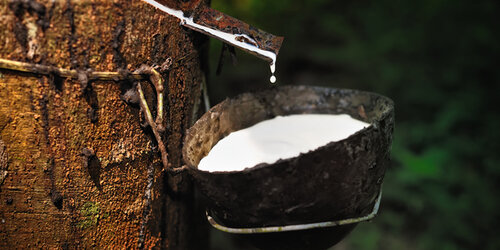
Natural latex has no odor, does not off-gas, and is not photo-reactive like petroleum based foam, which can turn brown, and begin to pill and crumble after even minimal exposure to sunlight. This phenomenon is most observable when you unzip the cover on old couch cushions which are exposed to daylight over long periods of time, even covered up.
Pure, botanically derived latex is also petroleum free, as it is sourced directly from the cambium layer of a Hevea brasiliensis tree, and the liquid is solidified into the springy and toxic free substance. Be aware that mattresses can also be made of synthetic latex, called “SBR”, for styrene butadiene rubber, made using petroleum products. Natural latex is more buoyant, bouncy, and livelier, and can last literally for decades.
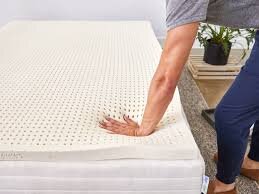
The real comfort bullet point about latex in general is that it pushes back against your body from below, and helps to evenly distribute your weight, offering a very buoyant and weightless kind of sensation. When you press your hand into it, it tends to compress in a large radius around it, distributing your weight more effectively.
After making latex mattresses for years, preferences began to change. More retailers and mattress designers began creating less expensive versions that included the polyurethane support layer (which made the mattress lighter and easier to handle) as well as a memory foam layer right beneath the top layer of natural latex.
Typically, a firmer layer will be used as the foundation or support layer, with increasingly softer layers as you get to the top. Often a natural fiber is used for the outer covering too, like bamboo or organic cover.
In fact, mattress designers began to take cues from owners who became comfortable with materials used in mattress crafting, and wanted a mattress that had unique properties which could only be found in a design that incorporated memory foam and latex in the same mattress.
The only limitation was that these mattresses generally were on the softer side, and they didn’t work well with heavier sleepers, who needed a much firmer- yet just as springier- underlying layer of support.
Pocketed Coils Can Add Comfort And Support For Heavier People
Innerspring mattresses were about the only option for a mattress for about one hundred years, since their development in the 19th century. The filler materials up top were usually animal hair, matted moss, or linter cotton. Today, coil systems are a highly advanced technology, especially when you look at hybrid mattress options on the market.
Rather than being coiled together in a rack type configuration, systems have been designed where individual (pocketed) coils operate independently from neighboring coils, allowing for pinpoint support and comfort, by applying pressure only where needed, and filling in void areas like between hips and rib cage, and the void space between shoulder blades for example.
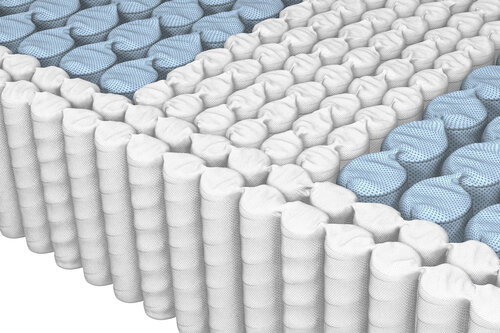
Typically, coil mattresses have one or more layers of spring coils (generally steel) that provide the support and comfort. the higher the coil count in a pocketed coil mattress for example, directly ties to the comfort you receive, so opt for high coil count (1100-1200 on a queen size mattress for example) if you consider a pocketed coil hybrid mattress option.
Putting All Of the Best Components Together In One Mattress
If I was going to create a mattress that was to gather up all of the components available to build a bed that was the most comfortable mattress I could design, it would no doubt have a combination of memory foam, latex, and a pocketed coil system. I’d also consider the other textiles, too, and would provide a tufted pillow top that had a little bit of plushness too it, as well..but, I wouldn’t make it too thick.
My “most comfortable mattress” would offer support, but you wouldn’t find it excessively firm, but uniform in distributing weight, and applying minimal pressure to areas like hips or shoulders. The latex would add a spring quality, helping to keep you buoyant and allowing for easy moving and turning. I’d place the latex above the memory foam , since the pressure relieving qualities it offers would also be experienced as you settled into the latex.
Beneath the top layers of latex and memory foam, I’d also use a pocketed coil system that is 8” tall, making the overall height of the mattress 13” tall, typically considered ideal for mattress height. Each of the layers of memory foam and later would be 2” tall each. the last inch would be the pillow top piece that would add a bit of softness and sumptuousness to the overall feel.
Now, for the reveal- my version of “the most comfortable mattress you can find” is already made by several companies who build a very similar mattress! Each has its own signature elements and qualities, and each selection we offer offers excellent pricing considering the caliber of the components used. Take a look at my curated list of hybrid mattresses that we know you will love.